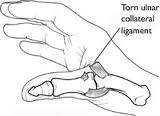Finger and thumb sprain is injury to a joint that causes a stretch or tear in a ligament. Ligaments are strong bands of tissue that connect one bone to another. A sprain usually occurs when there is an accident. For example, a ball may hit the tip of your finger or you may fall forcefully onto your finger.
Finger and thumb sprain symptoms include pain, swelling, and tenderness in your finger and thumb sprain.
 Finger and Thumb Sprain: Diagnosis/Definition
Finger and Thumb Sprain: Diagnosis/Definition
Finger and thumb sprain are common injuries. Most are relatively minor injuries and heal uneventfully. Early recognition and treatment may prevent chronic disability. Sprains are caused by either excessive lateral angulation at the joint, thereby stretching the collateral ligaments or by hyperextension causing injury to the volar plate.
- Grade I – pain at the joint with minimal swelling and no instability.
- Grade II – increased pain and swelling at the joint with mild laxity; complete instability is not present.
- Grade III – complete instability of the joint is present with complete disruption of the supporting ligaments.
Finger and Thumb Sprain: Initial Diagnosis and Management
- History and physical examination.
- Vascular examination (capillary refill)
- Neurologic examination (should be performed distal to the injury)
- Radiographic examination
- Test and record active and passive ROM
- Flexibility and strength testing
- Lateral stress should be applied to the joint in full extension and 45 degree flexion to determine collateral ligament stability.
- Appropriate restrictions of activity
- Ice compression if needed
Finger and Thumb Sprain: Ongoing Management and Objectives
- For Grade I sprains, buddy taping is usually sufficient
- For Grade II sprains, immobilization in a dorsal aluminum splint for 7-10 days in slight flexion is indicated.
- Buddy taping with ROM may start thereafter
- Flexion should not exceed 90 degrees
- Buddy taping should continue until healed
- For Grade III sprains, treat as in Grade II, however a full finger splint should be used in place of buddy taping.
Indication a Profile is Needed
- Any limitations that affect strength, range of motion, and general efficiency of arms.
- Slightly limited mobility of joints, muscular weakness, or other musculo-skeletal defects that may prevent hand-to-hand fighting and disqualifies for prolonged effort.
- Defects or impairments that require significant restriction of use
